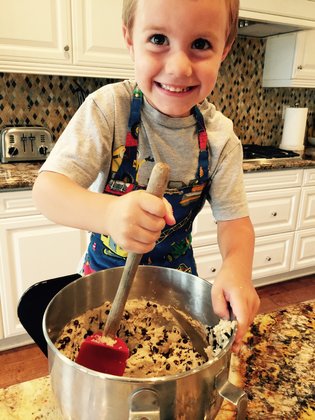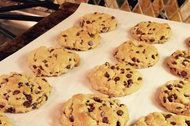
Kelly Rudnicki’s son Michael, 6, prepares batter for cookies that are allergy-safe for her family.Credit Kelly Rudnicki
“I always think that my kids eat healthier because of their allergies,” said Cristina Henriquez, a writer who lives in Chicago. Her children are 8 and 3 and, between them, are allergic to eggs, peanuts, fish, shellfish, dairy and tree nuts. There’s very little processed food in their house, she notes, and they eat out very rarely.
“When we do find something they can eat, particularly if it’s in the category of sweets or baked goods,” because dairy and egg allergies rule out many sweets, “they’re really excited and much more appreciative,” she said. “A treat really is a treat for them.”
Four out of every hundred children in the United States suffer from a food allergy, according to the Centers for Disease Control and Prevention. And the problem appears to be getting worse. From 1997 to 2007, the prevalence of food allergies increased 18 percent among children.
Symptoms of food allergy range from mild tingling and hives around the mouth to a severe life-threatening reaction. Eight foods — milk, eggs, peanuts, tree nuts, fish, shellfish, soy and wheat — account for 90 percent of allergic reactions to food.
While most parents worry about whether their children are eating healthful foods, parents of children with food allergies have far more at stake. Cooking every night or avoiding fast food can seem like an enormous challenge, but when your child has a life-threatening allergy you have few options.
I spoke with three families of children with food allergies about how they cope. Here are seven lessons they taught me about healthful eating they’ve learned that can apply to every family.
Anyone can learn to cook. “I was not a cook at all,” said Kelly Rudnicki, a mother of five children in Los Angeles who has written three allergy-friendly cookbooks since her son, now 13, was found to have life-threatening allergies to peanuts, tree nuts, dairy, eggs, peas and legumes. “We were living in Chicago. I never cooked one thing. We ate out all the time.” Her son’s diagnosis “totally changed how we function as a family. It forced me to teach myself how to cook.” Trying recipes and making substitutions wasn’t as hard as she had feared.
Planning ahead makes everything easier. When making a quick stop for breakfast on the way to an early morning game or grabbing a snack out before practice isn’t an option, planning ahead for those moments (prime time for less-than-healthy choices) becomes second nature. “There’s no not planning ahead,” said Susannah Fuchs, whose 9- and 12-year-old sons are each allergic to peanuts and tree nuts. “There’s no choice, so we do it.”
Cooking doesn’t have to take too much time. “You think you don’t have time to make something,” says Ms. Rudnicki, “but it’s not that big of a deal. It’s 10 minutes of extra planning,” and a little time to prepare. Her key to cooking very nearly every meal for her family is simplicity. “Baked potato bars. Breakfast for dinner,” she says. “My first cookbook didn’t include one recipe that involved sautéing. It’s all slow cooker and roasting and things you can do with a lot of little kids underfoot.” A favorite in their house is Turkey Sloppy Joes.
Processed foods aren’t irresistible. Between the marketing power of big food and the need to pack lunches and snacks with kid appeal that travel well, life without a stash of prepackaged food can seem impossible. Even families dealing with food allergies can usually find some go-to safe packaged choices. But they’re always checking the labels, always aware of every ingredient, and tend to substitute homemade snacks, fruit and whole food choices where they can. “If we can’t find something that they can eat, we try to make it for them,” said Ms. Henriquez.
Last Halloween, when all of the candy corn she could find either contained egg or was made in factories that also processed nut products, she used a recipe she found online to make her own. The candy corn, she says, wasn’t really a success — but cinnamon doughnuts and oatmeal and carrot muffins have been recent hits.
Children can learn to speak for themselves. As they grow older, children who have food allergies need to be able to look out for themselves, and that means being able to ask questions of adults, and convey the importance of what they’re asking. If a 12-year-old is out with friends and ordering a hamburger, he may need to ask the person at the grill whether there are peanuts or tree nuts in the food, noted Ms. Fuchs, whose nut-allergic son recently found himself in that situation. “It does require you to overcome any shyness.”
We can learn what’s in our food, and where it comes from. Reading labels means that parents as well as older children in food-allergic families are hyper-aware of every ingredient. Ms. Fuchs says that her son’s nut allergies “have made our eating cleaner and simpler.” The need to call and ask about processing methods means she knows where the foods come from, and the need to decipher every word on a label in search of hidden allergens means she’s had to learn the details of food production. “We have preservatives that are permitted in this country that aren’t permitted other places,” she says.
Even ingredients that aren’t allergens can now make her pause. When her family eats in restaurants, which is rare, they choose “mom-and-pop places where you can talk to the cook.” Eating foods that include only ingredients your grandmother would recognize makes it easier to spot a problem — “milk” is easier to decipher than “hydrolyzed casein.”
You can’t control everything. “We have to learn to live with fear and risk,” said Ms. Rudnicki, whose son had an allergic reaction to a chocolate-flavored frozen treat when he was in seventh grade and she wasn’t at home. Some kids, she said, get tired of always being the special case and take chances. “He knew immediately.” His sister, then 14, used his Epi-Pen before calling 911. “She knew what to do and how to do it.”

Kelly Rudnicki’s cookies, made from a recipe that is safe for her son’s allergies.Credit Kelly Rudnicki







